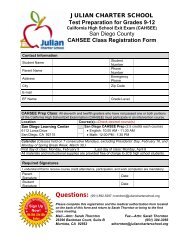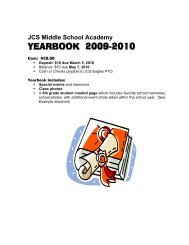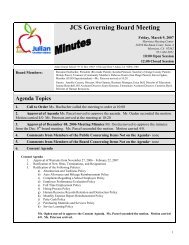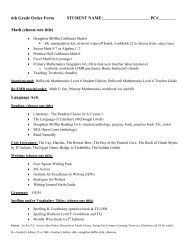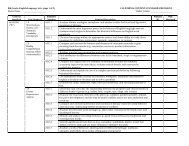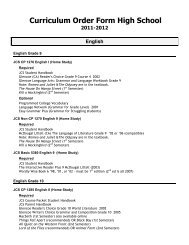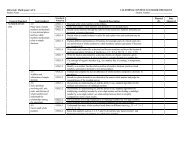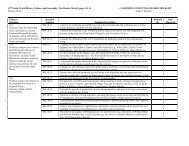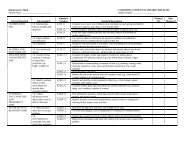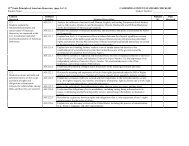2009-2010 Self-Study WASC Action Plan - Julian Charter School
2009-2010 Self-Study WASC Action Plan - Julian Charter School
2009-2010 Self-Study WASC Action Plan - Julian Charter School
You also want an ePaper? Increase the reach of your titles
YUMPU automatically turns print PDFs into web optimized ePapers that Google loves.
Detailed information about AYP, including participation rates and percent proficient results by student group, can be found<br />
at the CDE Adequate Yearly Progress (AYP) Web page.<br />
AYP Overall and by Criteria (<strong>School</strong> Year 2008-09)<br />
This table displays an indication of whether the school and the district made AYP overall and whether the school and the<br />
district met each of the AYP criteria.<br />
AYP Criteria <strong>School</strong> District<br />
Overall No No<br />
Participation Rate - English-Language Arts No Yes<br />
Participation Rate - Mathematics No Yes<br />
Percent Proficient - English-Language Arts Yes Yes<br />
Percent Proficient - Mathematics No No<br />
API Yes Yes<br />
Graduation Rate No N/A<br />
Federal Intervention Program (<strong>School</strong> Year <strong>2009</strong>-10)<br />
<strong>School</strong>s and districts receiving federal Title I funding enter Program Improvement (PI) if they do not make AYP for two<br />
consecutive years in the same content area (English-language arts or mathematics) or on the same indicator (API or<br />
graduation rate). After entering PI, schools and districts advance to the next level of intervention with each additional year<br />
that they do not make AYP. Detailed information about PI identification can be found at the Adequate Yearly Progress<br />
(AYP) Web page.<br />
Indicator <strong>School</strong> District<br />
Program Improvement Status Not in PI Not in PI<br />
First Year of Program Improvement<br />
Year in Program Improvement<br />
Number of <strong>School</strong>s Currently in Program Improvement<br />
N/A<br />
Percent of <strong>School</strong>s Currently in Program Improvement<br />
N/A<br />
XI. <strong>School</strong> Completion and Postsecondary Preparation<br />
Admission Requirements for California Public Universities<br />
University of California<br />
Admission requirements for the University of California (UC) follow guidelines set forth in the Master <strong>Plan</strong>, which requires<br />
that the top one-eighth of the state’s high school graduates, as well as those transfer students who have successfully<br />
completed specified college work, be eligible for admission to the UC. These requirements are designed to ensure that all<br />
eligible students are adequately prepared for University-level work. For general admissions requirements please visit the<br />
General Admissions Information University of California Web page.<br />
California State University<br />
Admission requirements for the California State University (CSU) use three factors to determine eligibility. They are<br />
specific high school courses; grades in specified courses and test scores; and graduation from high school. Some<br />
campuses have higher standards for particular majors or students who live outside the local campus area. Because of the<br />
number of students who apply, a few campuses have higher standards (supplementary admission criteria) for all<br />
applicants. Most CSU campuses utilize local admission guarantee policies for students who graduate or transfer from high<br />
schools and colleges that are historically served by a CSU campus in that region. For general admissions requirements<br />
please visit the Undergraduate Admission and Requirements Web page.<br />
Dropout Rate and Graduation Rate<br />
This table displays the school’s one-year dropout rates and graduation rates for the most recent three-year period for<br />
which data is available. For comparison purposes, data are also provided at the district and state levels. Detailed<br />
information about dropout rates and graduation rates can be found on the DataQuest Web page at<br />
http://dq.cde.ca.gov/dataquest/.<br />
Appendix<br />
<strong>Julian</strong> <strong>Charter</strong> <strong>School</strong> Focus on Learning <strong>2009</strong>-<strong>2010</strong> 141



